 EdTech Archives
International Consortium for Innovation and Collaboration in Learning Engineering (ICICLE) 2024 Conference Proceedings: Solving for Complexity at Scale
EdTech Archives
International Consortium for Innovation and Collaboration in Learning Engineering (ICICLE) 2024 Conference Proceedings: Solving for Complexity at Scale
 EdTech Archives
International Consortium for Innovation and Collaboration in Learning Engineering (ICICLE) 2024 Conference Proceedings: Solving for Complexity at Scale
EdTech Archives
International Consortium for Innovation and Collaboration in Learning Engineering (ICICLE) 2024 Conference Proceedings: Solving for Complexity at Scale
What does it look like to apply learning engineering principles and tools to design a sustainable and impactful learning experience? How can resources like conjecture maps, design journals, and learner personas—and practices such as human-centered design and iterative development—be meaningfully leveraged to support digital literacy training? This proceeding reflects on a yearlong effort by the Marylanders Online team[1] at University of Maryland Extension (UME) to design and pilot a training program for digital navigators at the Enoch Pratt Free Library (EPFL)[2] in Baltimore, Maryland. Now being scaled and prepared for national rollout, this program is under the evaluation process using both quantitative and qualitative methods. Grounded in iterative feedback, community engagement, and a strong commitment to inclusive learning engineering (LE) principles, this case study offers a practical example of how LE can shape hybrid learning experiences and train-the-trainer models in the digital literacy landscape.
Learning engineering (LE) is a powerful framework that integrates learning sciences, instructional design, data analytics, and iterative refinement to ensure that educational experiences are both responsive to learners’ needs and scalable for broader impact (Dede, 2018). Developed in collaboration with University of Maryland Extension (UME) and the College of Information Studies (INFO), and funded by the American Rescue Plan, this curriculum design initiative—originally titled Pratt Adventure & Beyond (PAB)—was created to advance digital literacy, equity, and inclusion across the state of Maryland by leveraging the trusted infrastructure of public libraries and other anchor institutions. As the instructional designer leading this effort, I applied LE principles throughout the curriculum development process, ensuring that the training remained learner-centered, adaptable, and continuously refined through ongoing feedback. The result was a 10-module hybrid curriculum piloted at EPFL between March and December 2024. Recognizing its scalability and relevance, the program has since been rebranded as the Marylanders Online Navigator Education Toolkit (MONET), with the addition of two new modules focused on AI literacy to reflect the evolving nature of digital competency. MONET with 12 modules in total is now expected to serve as a sustainable, flexible model for digital literacy training that can be implemented across diverse communities both within and beyond Maryland. With ten full-time digital navigators trained through this curriculum, the program is expected to support approximately 400 inquiries and serves an estimated 1,200 community members per month.
The original Pratt Adventure & Beyond (PAB) curriculum was developed using a participatory design process to actively engage digital navigators and library staff, ensuring alignment with their instructional challenges and the diverse needs of the communities they serve (Subramaniam, 2016). The iterative development cycle, guided by formative assessment data, usability testing, and direct learner feedback, enabled continuous refinement of the training modules to maximize engagement and effectiveness. Digital literacy topics were curated based on a comprehensive learner needs assessment conducted by the Marylanders Online team (Harding et al., 2024), as well as internal evaluations conducted at the EPFL. Delivered in a hybrid format, the curriculum comprises ten self-paced online modules, each reinforced through interactive in-person workshops. This blended learning environment promotes flexibility, active learning, and practical skill application. The modules target core digital literacy competencies, outlined below:
Table 1
All 10 Modules of the PAB Curriculum
Module Title | Description | Module Title | Description |
|---|---|---|---|
Computers and Operating Systems | Basic computer functions, hardware, software, file management, and OS literacy | Mobile Devices | Navigation, settings, apps, and accessibility on smartphones and tablets |
Internet and Web Browsing | Safe and effective internet use, search strategies, and browser navigation | Email and Communication | Creating and managing email accounts, digital etiquette, and communication tools |
Productivity & Collaboration Tools | Using platforms like Google Workspace and Microsoft 365 for tasks and teamwork | Online Security and Privacy | Cybersecurity basics, password hygiene, scams, and protecting personal data |
Telehealth | Accessing healthcare online, using portals, and preparing for virtual visits | Soft Employability Skills | Patron support skills such as active listening, empathy, and troubleshooting |
Everyday Digital Skills | Practical digital tasks including online banking, bill pay, and tax filing | Remote Working and Learning | Tools and strategies for remote engagement, virtual collaboration, and time management |
This paper further explores the concrete methodologies and tools from learning engineering practices that shaped the development of the PAB curriculum—now rebranded as the MONET curriculum. It positions this effort as a replicable model for libraries and anchor institutions seeking to bridge the digital divide through inclusive, data-driven, learner-centered interventions.
The initial phase of developing this program was rooted in the learning sciences, which form the foundation of learning engineering by offering insight into how people learn and how the human mind processes information. These principles provide the theoretical and practical blueprint for designing effective learning experiences (Goodell & Kolodner, 2022, p. 76). Given that this initiative is designed for digital navigators and librarians who face real-world challenges in their daily work, I adopted a blended constructivist approach that integrates key principles from situated learning (Clancey, 1995) and problem-based learning (Barrows, 1986). This approach positions learners as active agents who construct knowledge through meaningful engagement with their environments—particularly through concrete, problem-solving scenarios. These scenarios are tailored to reflect the specific digital literacy and patron support issues encountered in library settings. This pedagogical framework is especially well-suited for adult learners pursuing professional development, meeting the needs of both newly hired digital navigators and seasoned librarians as they navigate the evolving demands of technology support in today’s libraries.
To achieve this, we identified the creation of immersive learning experiences as a pivotal element of the curriculum. These experiences enable librarians and digital navigators to engage with and explore pertinent 'problems' and scenarios that they are likely to encounter in their roles. Throughout the development process, we systematically gathered feedback from librarians to ensure that the workshop scenarios were as authentic and realistic as possible. This feedback harnessed a rich dataset derived from the diverse experiences of librarians who frequently interact with a variety of patrons and their respective support issues. As a result, we designed a series of scenario-solving and discussion-oriented in-person workshops that often feature demonstrations and engaging dialogues centered around real-world scenarios. For instance, one common scenario presented involves: “Mike, a 65-year-old Baltimore resident who recently retired, comes to the library seeking guidance on how to use Instagram to connect with his grandson. He has just received a Chromebook from the government, but this is his first experience using such a device.” In this scenario, learners are expected to engage in group discussions that address both the hard skills required for using devices like Chromebooks and the differences between using them and laptops or mobile devices. They also delve into how to navigate applications such as Instagram while incorporating essential soft skills for effective patron support. Conversations might include suggestions such as, “First, you should inform him about the basic Chromebook training workshop happening at EPFL,” or “Encourage him to complete a basic Instagram course module,” or “Sit alongside him to navigate Instagram together with patience.” Such dialogues foster active learning, allowing participants to apply their knowledge as digital navigators in real-world situations, thus enhancing their capacity to provide meaningful support to patrons.
Furthermore, recognizing that this initiative trains future trainers, the curriculum includes essential instructor-focused components, offering facilitation strategies and techniques called ‘digital navigator tips and tricks’ embedded in learning materials, designed to empower participants to lead their own training sessions effectively. By equipping digital navigators and librarians with the tools and confidence needed to facilitate these discussions, we aimed to foster a supportive community of practice that enhances digital literacy and navigation skills across diverse patron demographics.
A human-centered approach is foundational to learning engineering, requiring a series of deliberate, iterative activities to deeply understand end users and their environments. These activities include observing users in context, consulting relevant literature, and conducting interviews to gain insights into user needs and challenges. Based on these insights, ideation involves generating design solutions grounded in the real-world experiences of users. These solutions are then translated into rapid prototypes that can be evaluated through user testing, with the goal of gathering preference and usability data from the intended audience. Feedback from these tests informs redesigns, progressively refining the prototype through iterative cycles involving increasingly realistic settings and a broader range of stakeholders, until a satisfactory, effective solution is achieved (Goodell & Kolodner, 2022, pp. 85–86).
This methodology was a core component of the PAB curriculum design. We actively engaged practitioners and stakeholders at the EPFL, including newly hired digital navigators and seasoned internal training managers—both end users and those responsible for training them. For example, feedback collected during each session of the pilot phase was immediately integrated into the next iteration of the curriculum. One participant from the initial face-to-face workshop on Chromebooks recommended adding direct pop-up notifications to indicate correct or incorrect answers in the online modules. This suggestion was implemented in the third online module. Similarly, feedback on the realism of scenario-based activities led to adjustments that better reflected the authentic interactions digital navigators have with patrons. This iterative, learner-centered design approach remains central to the ongoing refinement and scaling of the curriculum at UME and beyond.
Additionally, the PAB design process was deeply informed by participatory design (also known as co-design), a key concept that aligns closely with human-centered design in learning engineering. Participatory design emphasizes the involvement of a diverse set of stakeholders throughout the development process—from early exploration and discovery to prototyping and testing (Goodell & Kolodner, 2022, p. 91). I adopted this approach to ensure that those most affected by the curriculum—digital navigators and support staff—had an active voice in shaping it. This method is grounded in the belief that users bring essential expertise and lived experience, which enhances the relevance, usability, and effectiveness of the final product. As Subramaniam et al. (2016) note, participatory design fosters a sense of ownership among stakeholders and ensures that training tools are tailored to actual needs. This learner-centered, participatory methodology reflects a central tenet of the learning engineering community: that the design of learning experiences should be both evidence-based and co-constructed with those who will benefit from them.
Figure 1
Learner Population Needs Analysis.
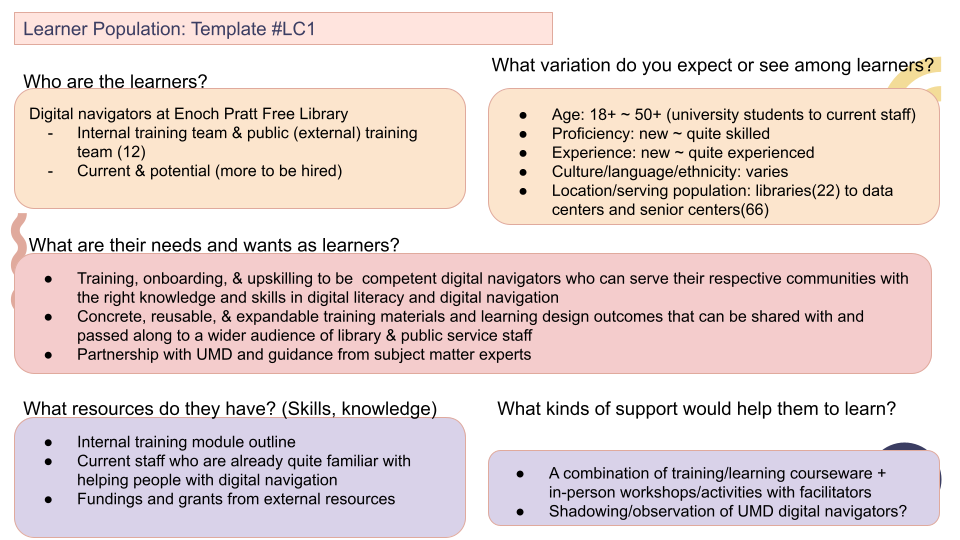
Accordingly, I began with a thorough needs analysis of the target learner population to understand who they are, the context in which they work, and what they expect and need from a training experience (see Figure 1). This foundational inquiry involved collecting data through conversations with key stakeholders and examining the challenges faced by digital navigators and librarians, particularly those newly hired or transitioning into technology support roles. This learner-centered analysis shaped the direction of the curriculum, ensuring alignment with the actual tasks and digital literacy issues encountered in public libraries. Following the needs analysis, I reviewed and audited pre-existing training materials used by the EPFL internal training team (see Figure 2). These included onboarding documents, digital device tutorials, and internal cheat sheets. Rather than discarding these materials, I sought to enhance and reframe them based on collaborative feedback from practitioners, especially those already engaged in training or mentoring digital navigators. Once initial prototypes were developed based on the synthesized feedback and content audit, I conducted low-fidelity testing with stakeholders to evaluate usability and instructional clarity (see Figure 3). These sessions—conducted both in-person and virtually with several stakeholders—allowed me to collect direct feedback on everything from instructional flow to visual layout. This stage of the design process naturally aligned with a core principle of learning engineering: iterative development grounded in continuous feedback cycles. Specifically, I employed a design-based research (DBR) approach, which emphasizes iterative cycles of design, enactment, analysis, and redesign aimed at improving educational practice and generating contextually situated knowledge (Brown, 1992; Design-Based Research Collective, 2003).
One illustrative example of this feedback-driven design occurred during the pilot of our first online module. Initially, assessments were embedded without revealing correct answers, under the assumption that delayed feedback might promote deeper reflection. However, participants voiced a clear preference for immediate, in-context feedback with pop-up explanations. In response, I modified subsequent modules to include real-time feedback, making the assessments more interactive and helpful for on-the-job application. Another point of feedback related to the realism of scenario-based learning content; some users found initial drafts too abstract or disconnected from their daily experiences. Revisions were made to ensure scenarios closely mirrored real patron interactions, drawing directly from anecdotes and use cases provided by EPFL staff.
This continuous cycle of review, testing, and revision was not only critical for improving the quality and usability of the learning experience, but also central to honoring and building upon existing institutional knowledge. By consciously setting aside my designer ego, I approached the curriculum development process with humility and collaboration, leveraging what already worked while adapting materials to new needs. Throughout this process, the curriculum remained anchored in a participatory design model, where stakeholders were treated not merely as informants but as co-creators. Their sustained involvement fostered a collaborative and empowering learning design culture. Ultimately, this learner-centered and iterative design process resulted in a curriculum that is both pedagogically sound and deeply attuned to the real-world challenges faced by digital navigators and librarians. It continues to evolve as we expand implementation across the University of Maryland and beyond.
Figure 2
Review of the Pre-existing Training Materials and Drafted Ideas.
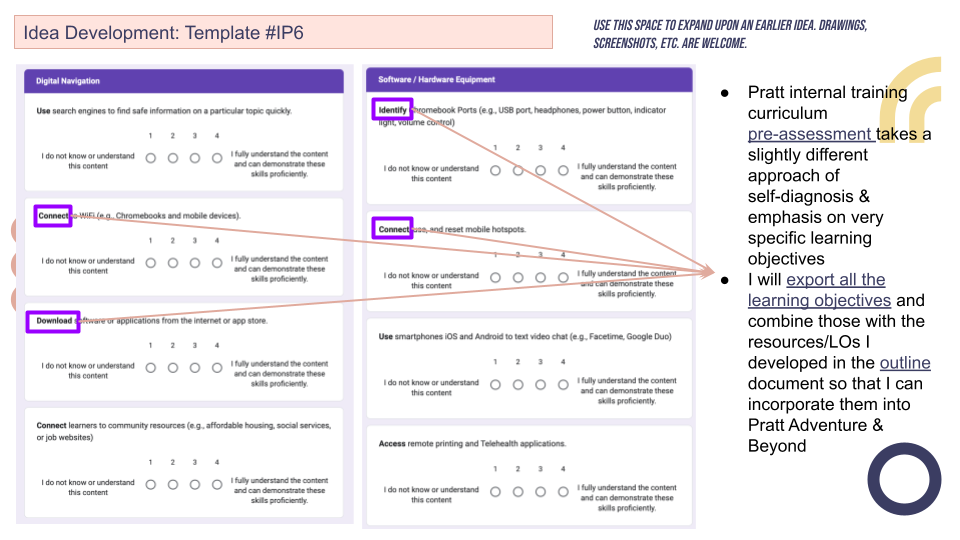
Figure 3
Prototype Testing Notes with Internal Stakeholders.
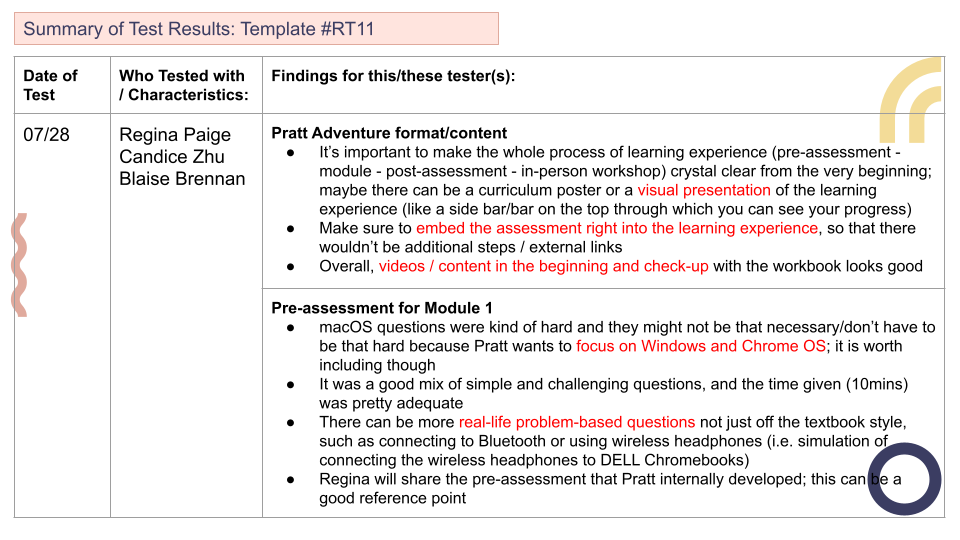
In my work as a learning engineer, structured tools like conjecture maps and design journals have been essential for designing and refining educational interventions in a systematic, theory-informed, and learner-responsive way. Conjecture mapping, as defined by Sandoval (2014), provides a methodological framework that connects learning theory to design practice. It distinguishes between theoretical conjectures—grounded in learning sciences—and design conjectures, which involve the instructional strategies and technological supports embedded in the learning experience. By explicitly linking design elements to anticipated learning outcomes, the conjecture map supports rigorous, evidence-based design decisions that can be tested and revised through iterative cycles.
Conjecture mapping was instrumental in aligning curriculum development with core learning objectives from the outset for PAB. Before any instructional materials were built, I established an initial conjecture map that outlined expected mediating processes—such as peer discussion and hands-on device troubleshooting—and linked them to intended learning outcomes for digital navigators. After each prototype testing phase, I revisited this map to assess which components were functioning as intended and where revisions were necessary. This process helped maintain a continuous focus on learner needs while ensuring fidelity to foundational learning principles. The conjecture map also enabled more granular design planning by identifying key embodiment elements—such as tools (e.g., cheat sheets, device demos), task structures (e.g., scenario-based practice), participant roles (e.g., peer facilitator, observer), and discursive practices (e.g., reflective debriefs). These design features were then tied to observable learning processes and outcomes, creating a roadmap that could guide both design development and implementation evaluation (see Figure 4). Importantly, the conjecture map served not only as a design scaffold but also as a boundary object—a shared, visual representation that facilitated collaborative dialogue with EPFL stakeholders. During regular meetings, we used the map to collectively revisit our assumptions, review evidence from learner interactions, and co-decide on design adjustments. This collaboration ensured that the curriculum remained grounded in our shared goals while adapting to practical realities and feedback from the field.
Figure 4
Revised Conjecture Map for PAB.
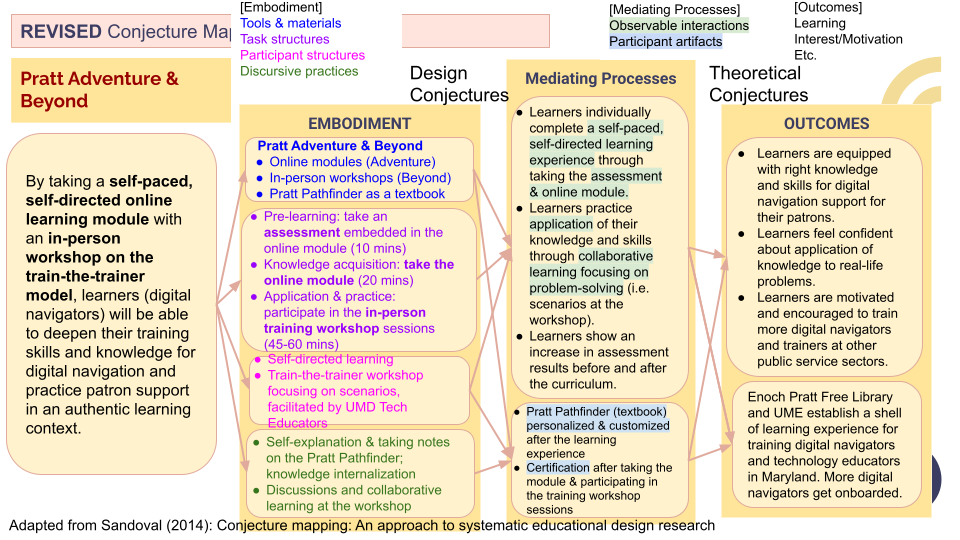
Complementing the conjecture map, the Design Journal was another critical tool throughout the project. Developed by faculty in the Master of Arts in Learning Engineering program at Boston College’s Lynch School of Education and Human Development, the journal templates offered a structured way to document each phase of the design journey. The fill-in-the-blank format prompted me to capture initial design hypotheses, iterative revisions, user feedback, and the rationale behind each change (see Figure 5.1). These journals helped me maintain a clear, traceable record of the curriculum's evolution and supported reflective practice, especially when decisions needed to be revisited or explained to collaborators. They were also useful for ensuring feedback was not only collected but translated into actionable changes—keeping the design process both learner-centered and responsive.
Figure 5.1
Prototype Testing Template from Design Journal.
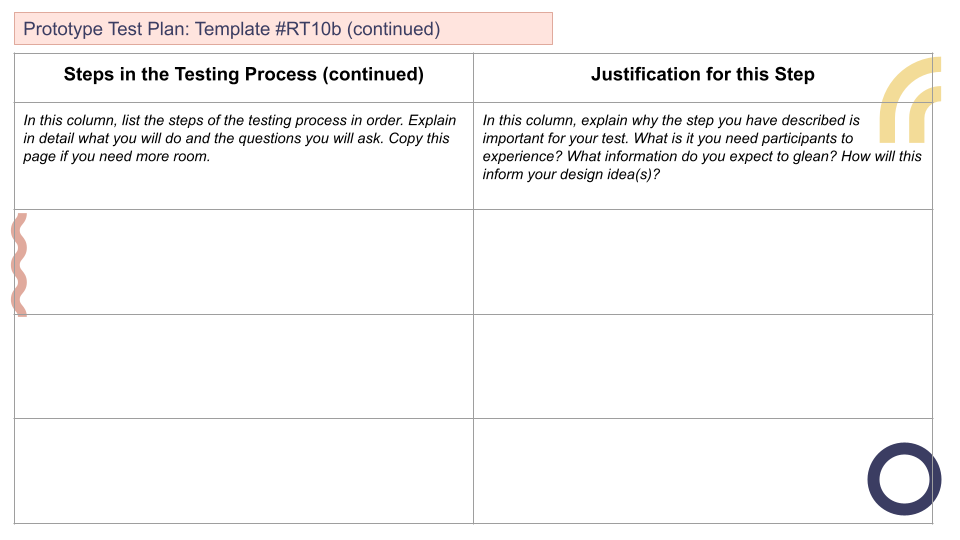
Figure 5.2
Prototype Testing Template Filled In.
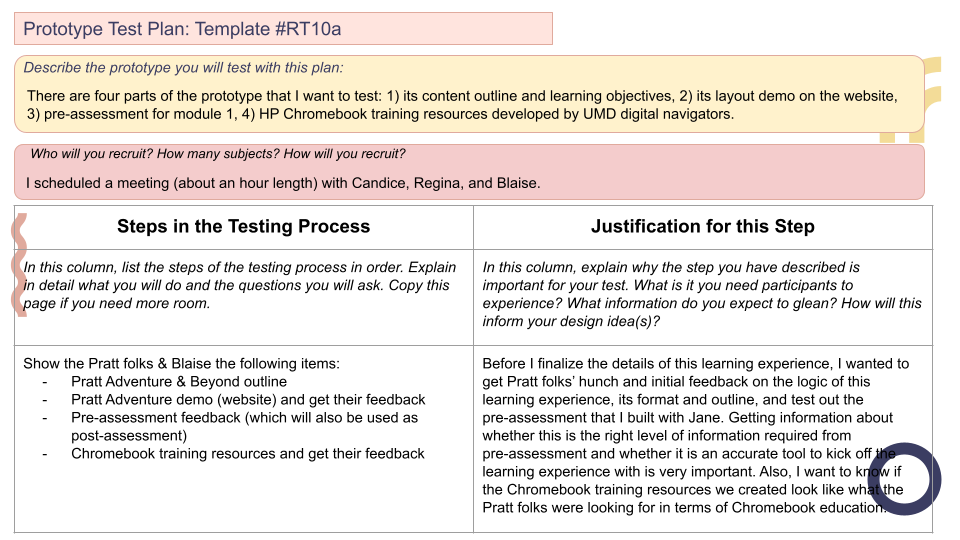
The value of these tools has extended beyond my own design process. For example, a Ph.D. student at the University of Maryland adopted the design journal template for her own participatory design study, and several professional track faculty at UME have begun incorporating these journals into their course planning workflows. This broader uptake speaks to the utility and adaptability of structured design tools in educational contexts.
In sum, tools like conjecture maps and design journals are more than optional supports—they are foundational instruments for carrying out learning engineering work in a rigorous and responsive manner. Together, they enable a dynamic design process that remains grounded in theory, shaped by data, and continually refined through cycles of testing and learner feedback. These tools helped ensure that the PAB curriculum not only met learning objectives but also adapted meaningfully to the lived experiences of librarians and digital navigators.
Lastly, it’s essential to underscore that the core values at the heart of Learning Engineering—particularly its ethical commitments—were integrated into the PAB curriculum design process from the very beginning. Learning Engineering is inherently a value-laden practice: every design choice reflects assumptions and priorities that affect learners, educators, and the communities they serve. Ethical considerations should never be an afterthought. As Goodell and Kolodner (2022, pp. 209–210) argue, ethical sense-making in Learning Engineering involves recognizing that our work influences real people and systems. Their practical framework outlines key principles such as: acknowledging that design decisions impact communities; understanding that learning engineers are community leaders; and accepting that ethical tensions and conflicts of commitment will inevitably arise and must be surfaced and addressed.
In my role as a learning engineer, I carry a strong commitment to justice, equity, diversity, and inclusion—what I refer to as JEDI values. These ideals were central to the design of the PAB curriculum, which focused specifically on key populations often left behind in digital inclusion efforts, including older adults, residents of rural communities, and individuals from low-income households. Our guiding belief: digital skills should be universally accessible. Echoing the spirit of the beloved line from Ratatouille—"Anyone can cook"—we firmly believe that "Anyone can use technology." The rationale behind developing this flexible, template-based training model—now being rebranded under the name MONET —is to ensure its sustainability and adaptability for diverse end users. More than a single-use curriculum, I desire MONET to contribute to a larger conversation about building a sustainable and impactful digital literacy ecosystem, one where all learners have the opportunity and the tools to build technology skills on their own terms. Importantly, our vision goes beyond the EPFL community or even Baltimore City. We intend for this curriculum to be adopted and adapted by other libraries, nonprofits, and community organizations across the state—and potentially the nation. By building a framework that is both durable and flexible, we aim to foster a learning ecosystem that can thrive even after initial grant funding ends or the original team moves on. Through this values-driven and community-grounded approach, we hope to leave a lasting legacy that empowers individuals and institutions to continuously expand digital access and literacy, and in doing so, move us closer to a more just and inclusive digital society. The lead author is currently serving as Principal Investigator on a study (pending approval from IRB) to evaluate the effectiveness and impact of the MONET curriculum on digital literacy outcomes. Findings from this research will be shared in future publications and presentations.
[1] https://marylandersonline.umd.edu/home/
[2] https://www.prattlibrary.org/
I would like to express my heartfelt gratitude to everyone who contributed to this initiative. Special thanks to the Marylanders Online team, and especially to my Ph.D. advisor, Dr. Mega Subramaniam, for her invaluable guidance throughout this process. I’m also deeply grateful to Ms. Regina Paige, my incredible collaborator at EPFL, whose partnership has been vital to this work. A sincere thank you to Dr. Janet Kolodner, my long-time mentor from my Boston College days, for encouraging my journey into the learning engineering community and offering advice that has profoundly influenced my design work. Lastly, I’m thankful to the faculty of Boston College’s M.A. in Learning Engineering program for sparking my interest in this field and for their continued inspiration, particularly through the development of the Design Journal, which remains an essential tool in my practice as a learning engineer.